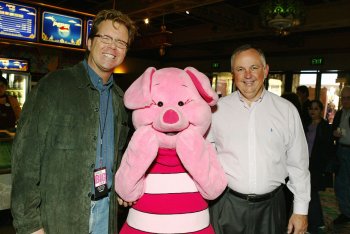
On my way through Denver today, I stopped by at the headquarters of
Starz Entertainment Group, located in an imposing stone-faced tower south of downtown. I sat down with corporate communications czar Eric Becker and
Bob Greene, SVP of Advanced Services. Starz, of course, runs some of your favorite premium cable channels, and they also have an Internet movie subscription service called
Starz Ticket. Our conversation focused on new ways that movies might be distributed and experienced. Greene made a number of really interesting observations and comments over morning coffee:
- Consumers want it to be easy to move content that they download (like movies) from one device to another; studios naturally want it to be hard, to keep a lid on piracy and excessive copying. Plus, “moving content around [from one device to another] doesn’t necessarily translate into increased revenues” for the studios, Greene says. They'd rather sell it to you once for your PC, once for your TV, once for your portable video player, etc. (Starz Ticket gives you a license to watch movies you get on three different computers.)
- Greene is bearish on the prospects of releasing movies simultaneously in every format (what's called "day and date"), in part because it hurts the value of his long-term licenses with the studios. (Starz has rights to some movies that last a decade.) But he also makes the case that it won’t make economic sense for the studios. “It’s impossible. The math won’t work. ...[Some people] will go buy the movie, some will see it in theaters, and some will download it,” Greene says. But the problem, according to Greene, is that fewer people will do several of those things (see in theater/see on premium cable/rent/buy), as they do today.
- Despite that, during our conversation, Greene toyed with the idea that studios might sell first-run movies for a premium price to people who wanted to watch them at home as soon as they're released. If you liked the movie, you might pay a few dollars more to own it permanently, and perhaps a few dollars on top of that to purchase the soundtrack or DVD-style extras. But ultimately, it sounds as though Greene doesn’t think the economics of that model will work for the studios.
“What if ten people are in the living room?” he asks. Will that group pay $5 or $7 each to the studio (or whoever provides it) to get access to a first-run movie at home? Today, Greene observes, “people are willing to pay multiple times for a movie, maybe adding up to $40 or $50. But they’re not willing to pay all that money up front, for the first-run viewing in their home.”
- Greene doesn’t think we’ll see an iTunes for movies anytime soon, because of rights issues. Different companies hold different rights. Starz, for instance, can sell movies only as part of a subscription-based offering, either on cable or on the Internet. They can’t sell movies as downloads that you’d own, a la iTunes.
(I'm not convinced that within two or three years, someone - maybe Apple, maybe not - will work with studios to sell digital downloads of movies that you'll own through a storefront with a very comprehensive selection.)
- Greene suggested that one major studio is working with Netflix to provide new releases for an Internet download or rental service being developed by that company. He wouldn’t say who, though. (Starz views Netflix as a competitor, much the same way it regards HBO and Showtime. For more background on Starz and Netflix, see
this CinemaTech entry from July.)
- Greene says that movies delivered digitally ought to be cheaper for consumers than those burned onto a DVD or shown in a theater. He also feels they should be truly transportable – not tied to just one device. I’m in complete agreement with him there.
- Greene thinks that consumers will be eager to put movies on handheld video players, like the Sony PlayStation Portable, devices from Archos, and a potential video iPod from Apple. He indicated that Starz is working on an extension to its Starz broadband movie service that’d support portable video players.








































